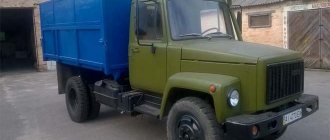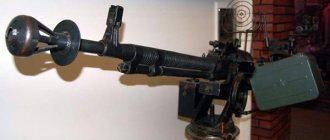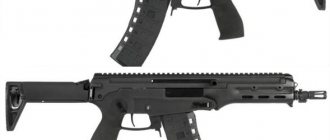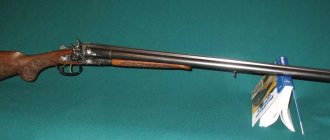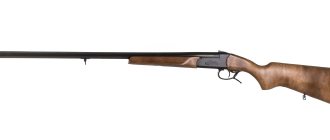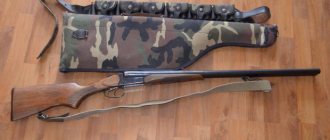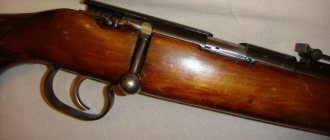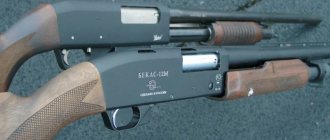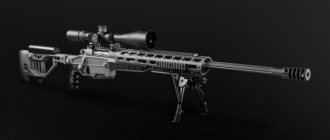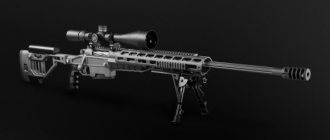The GAZ-69 SUV, created in the post-war years, became the main vehicle for the army and police for a long time. The “goat” design made it possible to operate on any type of road and run on low-quality gasoline. The car has not lost its relevance today. Some enthusiasts restore SUVs to factory condition, while others build expedition jeeps based on the GAZ-69, capable of driving on difficult off-road conditions.
Despite the fact that this car was produced for quite a long time, and only 19 years (1953...1972), it is still in service here and there. It can be found in the taiga and on the mountain slopes of the Caucasus, let the battered machines, but not losing their fighting spirit, do their job.
History of creation
The development of a new passenger SUV for the army and civil service began at GAZ in 1946 under the leadership of G.M. Wasserman. To speed up work and reduce the cost of production, standardized components were used in the design of the car. Initially, the all-terrain vehicle had the designation “Worker”. The technical specifications provided for the vehicle to operate together with a trailer weighing up to 800 kg.
The first prototypes appeared in 1948, and mass production began five years later. The car was produced in Gorky until 1956, then all the equipment was gradually transferred to Ulyanovsk - to the UlZiS plant.
For two years, the production of SUVs was carried out simultaneously at two production sites. After the final development of production, the plant in Ulyanovsk was renamed UAZ, and the cars were renamed UAZ-69 and UAZ-69A, respectively.
The production of SUVs continued until 1972 and was discontinued after the assembly of more than 634 thousand vehicles.
Advantages and disadvantages
Place an ad on our website: Orders for special equipment
Before you buy a Gas 69 from storage, you need to understand the features of this transport, its strengths and weaknesses. Advantages:
- more comfortable and convenient interior when compared with Gas 67;
- thoughtful and simple design;
- ease of repair;
- spacious trunk;
- universality of application in the military and civilian spheres;
- It is possible to install a diesel engine instead of a gasoline engine.
Flaws:
- an overly simple version of the canvas top;
- stiff and “bouncing” suspension;
- weak dynamics;
- high fuel consumption;
- not very good handling;
- almost complete lack of sound insulation in the cabin;
- weak power, which is especially important at the current stage.
As you can see, the main disadvantages are due to the characteristics of the vehicle in relation to the time when it was used. For that period it was a good car, which is confirmed by the long production period and the popularity of transport in the Soviet Union and other countries.
Design
The basis of the SUV is a frame of complex shape with side members of a closed profile. To increase rigidity, the frame is equipped with additional cross members. The axle suspensions are spring and equipped with lever shock absorbers.
The axle housings are split along a vertical flange. The stockings are pressed into halves and additionally secured with rivets.
Engine
The first production GAZ-69 SUV was equipped with a 4-cylinder gasoline engine producing 52 hp. The engine is unified with the unit from the GAZ-M20 Pobeda. Gasoline with an octane rating of at least A66 was used as fuel.
Body GAZ-69 model 76
The body is open type, designed for 8 people. The driver and front passenger are seated in separate front row seats. The places are equipped with individual non-symmetrical doors.
The driver's door has a trapezoidal shape due to the installation of a spare wheel on the side of the body.
Six people can be accommodated in the rear of the body on two folding benches. Under the benches there are metal boxes designed to store tools and spare parts.
The all-terrain vehicle body allows one wounded person to be transported on a stretcher mounted on the dashboard handrail and rear side. The backrest of the passenger seat folds forward and does not interfere with the installation of a stretcher. The accompanying person is placed on the left side bench.
All-terrain vehicles GAZ-69A are equipped with two fuel tanks.
The main tank holds 47 liters of gasoline and is located between the frame side members, under the body floor. An additional 28 liter tank is installed under the front passenger seat. The tanks are connected to each other by fuel lines.
Body GAZ-69A model 77
The GAZ-69A all-terrain vehicle is equipped with a metal open body with 4 doors. The cabin has two rows of seats - for the driver and passenger in the front and for 3 passengers in the back. The rear row of seats could be folded.
The tailgate is unified; the internal volume is used to store a tow rope and other equipment. The vehicle is equipped with a 60-liter fuel tank installed in the rear of the body.
Chassis GAZ-69A
The basis of the all-terrain vehicle is a frame of complex geometric shape. The side spars are made from stamped sheet steel. To increase torsional rigidity, the frame is equipped with additional cross members.
The leaf springs of the front and rear axle suspensions are attached to the frame. Each axle is additionally equipped with two lever shock absorbers. Axle housings consist of two halves that open along a vertical flange. The axle shaft stockings are pressed into the crankcase halves and additionally secured with rivets.
Devices
The GAZ-69 and 69A all-terrain vehicles are equipped with the same instrument panel, on which a speed indicator, an ammeter, an indicator of the amount of fuel in the tank, an engine temperature indicator and a lubrication system pressure gauge are installed.
The instrument cluster is equipped with two backlight lamps covered with metal light diffusers.
In addition to the instruments, there are two warning lamps - high beam headlights (red) and engine overheating (green).
Brake system
The GAZ-69 all-terrain vehicle is equipped with a brake system with hydraulic pad drive. Drum-type mechanisms are located on wheel hubs. The drums are cast from cast iron, the working part consists of a steel ring cast into the body of the part.
When parked, the car is held from the driver's seat by an additional cable-driven drum mechanism. The mechanism is installed on the output shaft of the transfer gearbox.
Steering
The steering column of the GAZ-69 and 69A all-terrain vehicles is located on the left side. The column is rigidly mounted on the body, inside there is a shaft on bearings connected by a gearbox. The shaft rotates a globoidal worm, along which a double roller connected to a bipod moves.
The wheels are turned by tubular rods located in front of the axle. The steering wheel is 3-spoke, made of black plastic.
GAZ-19 short history
Photo GAZ-19 Communication
Having mastered the production of cars of the GAZ-69 family with a 4x4 wheel arrangement in 1953–54, the Gorky Automobile Plant developed an original rear-wheel drive version of the all-terrain vehicle, which received the code GAZ-19
.
In addition to the fact that GAZ’s production program would expand due to the promising SUV, this car, equipped not with a tilt, but with a closed all-metal van body, could be used for transporting mail and other universal cargo weighing up to 600 kg, as well as in emergency services and authorities of the Ministry of Internal Affairs. The design of the car
, completely unified with other GAZ vehicles, ensured ease of maintenance and reliable operation in any road conditions.
The car body had two side doors and one double door located in the rear wall. It existed in two versions - with solid and glazed ( GAZ-19A modification
) side sides.
The cargo area was separated by a partition from the front seats intended for the driver and passenger. The maneuverability of the GAZ-19
was ensured by its short (2300 mm) wheelbase and small dimensions: length - 3850 mm, width - 1750 mm, height without load - 1950 mm, track - 1440 mm. The ground clearance of the GAZ-19 was 210 mm, the highest speed with a full load was 90 km/h. The engine, like that of the GAZ-69 all-terrain vehicle, was a gasoline, carburetor, 4-cylinder, with a displacement of 2.12 liters, a compression ratio of 6.5 and a power of 55 hp. With. at 3600 rpm.
In 1956 GAZ-19
was demonstrated at an exhibition of domestic automobile industry products in Moscow, but never went into production.
The reason that prevented it from mastering its production was the lack of a ready-made forged front axle beam, the production of which would supposedly be economically unprofitable due to the relatively small need for such vehicles in comparison with the army and agriculture. Nevertheless, subsequently, with the transfer of production of GAZ-69 and GAZ-69A cars to the Ulyanovsk Automobile Plant, forging of a similar beam was nevertheless established for the production of all-wheel drive UAZ-451
.
Modernization
The main customer for SUVs was the USSR Ministry of Defense, so the vehicles remained virtually unchanged during the production process. The only modernization was carried out at the beginning of 1970. The changes affected the glazing of the awning and introduced two cylinders in the front brake mechanisms.
The bridges were equipped with reinforced differentials, and a “mass” switch was introduced in the electrical system.
The most noticeable change was the ability to disable front wheel drive. The modernized SUVs received the designations UAZ-69-68 and 69A-68 (or 69M and 69AM).
GAZ-69A
But first you need to pull out the choke button (remember what that is?) and manage to press the very high starter pedal with your right foot. Having warmed up, the lower-valve engine - an analogue of the Pobedov engine - operates sedately and smoothly. Getting comfortable with the clutch is not at all difficult, although the effort is, of course, serious - male. But the gear shift is to a certain extent standard. We have already begun to forget how short and clear the strokes of the lever were when it entered directly into the box. The unsynchronized first one requires skill to turn on silently. But those who have mastered this simple craft have little reason to be proud. Brakes? Like almost all cars of that time. At first there is a long, free movement without resistance, and then the leg finally feels a serious obstacle, and the car, without zeal, very reluctantly, begins to slow down. It’s normal for the life for which a fighter on two fronts was being prepared... We’re already completely late! The fifty-horsepower engine accelerates the gas car faster than I expected. The outskirts are behind, take a dirt road to the highway.
DISTRICT DAYS
Technical characteristics of GAZ-69 and 69A
| M151 | GAZ-69 | GAZ-69A | |
| A country | USA | USSR | |
| Length, mm | 3380 | 3850 | |
| Width with spare wheel removed/installed, mm | 1630 | 1750/1850 | |
| Height (with awning), mm | 1800 | 2030 | 1920 |
| Maximum speed, km/h | 112 | 90 | |
| Gasoline consumption (average), l/100 km | 12 | 14 | |
| Capacity, persons + load capacity, kg | 4+360 or 2+544 | 8+0 or 2+500 | 5+50 |
| Engine power, hp | 72 | 55 | |
GAZ-69A
I open the narrow door (by the way, the back and front are the same - unification!). Images from childhood films immediately come to mind: endless virgin fields, tormented by a blizzard or playing with tall wheat, and a tall, stately chairman, say, Foma Gordeich, strict but wise, rarely smiling widely. And here is another episode: the border patrol is in a hurry to catch the insidious intruder. The outcome of the confrontation is known in advance, but this does not affect the interest of the audience...
To travel in winter, dressing according to current fashion is unforgivable frivolity. The stove in the car is quite decent, but it only heats while driving - there is no fan. In addition, from the interior, covered with a tarpaulin, the street is clearly visible through numerous cracks.
But anyone who drives a GAZ car (even in the back seat - here, in the GAZ-69A, it is normal, by the way, there are no longitudinal benches, as in the usual 69), is always ready for any hardships and hardships, whether military service or the one where they are fighting the “battle for the harvest.” Therefore, I got used to crawling through a narrow door (getting out, by the way, is even more difficult) and squeezing myself between a leatherette seat and a cold plastic steering wheel, not only in an overcoat and padded jacket, but sometimes in a sheepskin coat. With the gas pedal almost pressed to the powerful tunnel of the body, the experienced ones operated, some in boots, some in felt boots. And I, even in ordinary, civilian shoes, out of unaccustomment, first press... on the tunnel.
Application
For 20 years, GAZ-69 and 69A cars were the main light SUVs in the Soviet Army and the troops of the Warsaw Pact countries. The vehicles were used to transport personnel and as tractors for light artillery systems weighing up to 800 kg.
On the basis of army SUVs, special installations were created, for example, mobile radio stations or chemical reconnaissance vehicles. The vehicles were equipped with anti-tank missile launchers. One of the well-known modifications of the GAZ-69 is the 2P26 Shmel ATGM combat vehicle.
For the landing units, SUVs were delivered with the windshield frame removed and the protruding external elements removed. The GAZ-69 SUV was the basis for the GAZ-46 amphibious vehicle.
At airfields, the GAZ-69 was used as a carrier of the APA-12 starter complex, designed to launch turbojet engines.
Civilian GAZ-69 SUVs were popular as police and traffic police patrol cars.
Cars often lost their awnings, instead of which a metal top was installed. The work was carried out at provincial auto repair plants. Cars came into private ownership only after they were written off from government agencies.
It should be noted that GAZ-69 vehicles gained great popularity in the Caucasus and Siberia, where they were widely used as all-terrain vehicles. Elements of the GAZ-69 chassis were used in the design of the GAZ-M72, an original all-wheel drive vehicle based on the Pobeda body. The SUV was produced in Romania at the ARO plant until 1975.
Soviet combat "Goats" GAZ-69: headquarters, artillery, anti-tank and more
The well-known Soviet jeep GAZ-69 with popular nicknames “Goat” or “Bobik” laid the foundation for the installation of various lightweight transportable or mounted military equipment on new all-terrain vehicles. However, in October 1947, his first prototype “Truzhenik”
officially created for agriculture.
True, in the secret technical specifications it bore a completely different name - a tractor for battalion guns and mortars. Over the next two years, four more prototypes of the GAZ-69-76
with all-metal bodies and characteristic cutouts in the folding rectangular awning, which received the index ATK-L-69 - a light wheeled artillery tractor.
Prototype GAZ-69 with semicircular cutouts in the awning. 1948
One of the first four prototypes with blank sides of the engine compartment
In 1951, state tests were carried out on modified GAZ-69 military vehicles on herringbone tires in conjunction with light guns. During the tests, a film was made, which was shown to I.V. Stalin, which predetermined the further successful fate of the car and contributed to its rapid adoption.
Simplified pre-production version of the GAZ-69-76 model 1951
In the fall of 1953, small-scale production of GAZ-69
with a reinforced spar frame, a 52-horsepower engine from the M-20 Pobeda passenger car and a three-speed gearbox with a two-speed transfer case. New items included driveshafts with needle bearings, axles with ball joints of equal angular velocities and semi-elliptical springs with double-acting hydraulic shock absorbers. The open two-door body with two front seats and two rear longitudinal benches accommodated up to nine people. Loads weighing up to 500 kilograms were also placed there and special superstructures were installed. The GAZ-69 was first presented at a military parade on November 7, 1953.
Serial army GAZ-69 with a side spare tire and a raised awning
GAZ-69 with a folding front window and rear longitudinal seats
Testing the GAZ-69 car with a single-axle GAZ-704 trailer on the ground
In 1955, serial production of the GAZ-69 was transferred to the Ulyanovsk Automobile Plant, which in the 60s switched to an updated version of the GAZ-69M
with a 65-horsepower M-21G engine from a UAZ-450 van with a new radiator for oil cooling and camouflage headlights.
Versions 69E
and
69ME
with shielded electrical equipment served mainly in the signal forces.
Modified GAZ-69M, assembled in Ulyanovsk for the Soviet army (archive of 21 NIITs)
A GAZ-69M car at a convention of vintage military vehicles.
In the background - GAZ-69AM (photo by the author) In 1969-1972, the last series of GAZ-69-68
with a 70-horsepower M-21V engine from a UAZ-452 truck, a front-wheel drive disconnect mechanism and reinforced drive axles. Externally, these cars were distinguished by an awning with two small side windows.
Secondary modernized cargo-passenger vehicle GAZ-69-68
Already in the first years of production, cars of the GAZ-69 family turned into the main light multi-purpose vehicles of the Soviet army. They were supplied to the Warsaw Pact states and to the armies of many neighboring and distant countries.
Since 1953, in parallel with the GAZ-69 model, the GAZ-69A
for use in agriculture, which also played an important role in military affairs. It differed from its older brother in having a four-door body with two rows of seats, a rear luggage compartment with a spare wheel and a sloping part of the canvas awning.
Five-seater military version of the GAZ-69A with a tilt body
Top view of the all-metal body of the GAZ-69A with the awning lowered.
1951 Its general design and parameters changed in parallel with the development of the base GAZ-69 vehicle, and shielded versions received the indexes 69AM
and
69A-68
respectively.
GAZ-69A staff vehicles at a military parade on Red Square.
On May 1, 1958, GAZ-69A/AM vehicles were in service with the USSR as command vehicles, traditionally leading military parades. In fraternal countries they served as multi-purpose, headquarters and ceremonial vehicles, and were also used for courier communications.
Soviet jeep GAZ-69A in the Romanian army during the celebration of Liberation Day. 1964
Military equipment on the GAZ-69 chassis
In the Soviet Union, representatives of the 69th family with various superstructures and weapons performed headquarters and ceremonial functions, served to transport small units, ammunition and small cargo, and also towed artillery systems weighing up to 800 kilograms.
A GAZ-69A car at the head of a column of Airborne Troops at a parade in Leningrad. 1958
GAZ-69A staff vehicle from the group of Soviet troops in Germany
GAZ-69 vehicles with trailed anti-aircraft guns during military maneuvers. 1955
To deliver the wounded, a two-tier stretcher for four people was equipped in the rear of the body. Cars with light radio stations and special signals were often used as patrol cars of the Military Traffic Inspectorate (VAI).
At the Moscow parade, GAZ-69 vehicles with Airborne Forces personnel. November 7, 1957
The Airborne Forces were armed with airborne versions of the GAZ-69 vehicles with dismantled windows and protruding external parts, and modified versions were delivered by transport planes and helicopters. Other vehicles of this generation were equipped with communications and reconnaissance equipment, machine guns of various calibers, anti-aircraft weapons and missile systems.
Special lightweight airborne version of the GAZ-69 car in the GDR
In Czechoslovakia, an air defense headquarters was installed on a GAZ-69M to control twin anti-aircraft systems on Praga V3S trucks. In the GDR, 12.7 mm machine guns and small radar systems were installed on the GAZ-63AM. In the armed forces of distant countries, LGANS served as a base for 82-mm mortars, recoilless rifles and light cannons.
GAZ-69AM with a DShK heavy machine gun in the People's Army of the GDR
Below we provide brief information on the most common and well-known military versions of the GAZ-69 family of vehicles.
The mobile topographic surveyor was based on a specially prepared GAZ-69T
and was a complex of topographic equipment for continuously determining the coordinates of military units, roads and individual objects, as well as laying communication routes and transferring them to the terrain.
Upgraded topographic vehicle GAZ-69ТГМ with expanded equipment
; Special radiation and chemical reconnaissance vehicle GAZ-69РХ
equipped with a complex of special instruments and means to determine the presence and degree of contamination of the air, terrain and military equipment with toxic substances known at that time.
GAZ-69РХ radiation and chemical reconnaissance vehicle in the Polish army
Light tube short-wave radio station R-104M “Kedr”
with its own batteries, it provided two-way radio communication with various objects on the move or in a parking lot. It was placed transversely in the rear compartment of the GAZ-69-68E car, and the folded telescopic antenna was mounted on the right side of the body.
GAZ-69-68E car with R-104AM radio station in the Finnish armed forces
Light radio stations R-125 “Alphabet”
provided radio communications between unit commanders and heads of various services of the Ground Forces. All equipment was mounted behind the front seats of GAZ-69E/ME vehicles. The radio operator was placed on a transverse bench, one or two whip antennas were mounted on brackets on the left side of the body.
Command and staff vehicle with a radio station R-125M on a GAZ-69ME chassis (archive of the 21st Scientific Research Center)
Internal equipment of the mobile radio station R-125M "Alphabet" in the People's Army of the GDR
Secret direction-finding complex " Orel-D"
", known as "Luch-1", was based on a camouflaged GAZ-69 chassis with a rigid casing and canvas covering instead of an awning. The rotating direction finder ensured the interception of radio signals while moving or parked at any time of the day.
Lightweight radio direction finder "Orel-D" with a reinforced top body.
1965 Airfield launch unit APA-12
used to start engines of light aircraft, carry out their maintenance and power electrical systems. Its basis was a special UAZ-917 chassis, which differed from the serial GAZ-69 by the presence of a power take-off, a separate two-seater cabin and a body with a rear hinged lid, under which there was a generator, batteries and instrumentation.
Airfield launch unit APA-12 on a UAZ-917 chassis.
1962 The first Soviet light road mine detector DIM
with a search induction scanning device on a converted GAZ-69 chassis, it was used to lay out routes for the movement of military columns, mechanize the search and detect various types of mines over large areas or at a depth of up to 70 centimeters. The working systems were suspended in the front of the vehicle frame and consisted of a lever-spring suspension, two steering wheels and six support rollers. An interesting feature of the vehicle was an additional right steering wheel for the operator who controlled the position of the mine detector.
Road induction mine detector DIM on a GAZ-69 car in the Polish army
Model of the DIM mine detector in the Museum of Artillery, Engineering Troops and Signal Corps in St. Petersburg (photo by the author)
The first Soviet light combat vehicle “Bumblebee”
for launching four anti-tank missiles, created in 1960, was based on the modified GAZ-69/69M chassis and was part of the 2K15 self-propelled missile system.
Launcher 2P26 "Bumblebee" on the GAZ-69M chassis in the Museum of Artillery and Engineering Troops (photo by the author)
It was equipped with a two-seater cabin with an armored rear wall and a raised canvas roof. The rear section of the frame with a high folding awning housed an artillery unit with guides for missiles with a firing range of up to two kilometers. In the cockpit next to the driver, on a special seat with the back facing the direction of travel, there was a gunner operator who controlled the missiles via a two-wire communication line.
Mobile anti-tank systems "Bumblebee" at a military parade in Egypt
Preparation for launching guided missiles weighing 22.5 kilograms
In 1966, this system was replaced by the Malyutka complex on a wheeled armored vehicle.
The title photo shows the Bumblebee launcher on a GAZ-69 chassis for launching anti-tank missiles on display at the Military Historical Museum of Artillery, Engineering and Signal Corps in St. Petersburg.
GAZ-69A
A slot in the tarpaulin under the flap is for presenting documents.
They'll figure it out! A slot in the tarpaulin under the flap is for presenting documents. They'll figure it out!
Of course, first of all, the GAZ car was made for the army, which was again going to fight, this time with former allies. Then came collective farmers, geologists and builders, for whom such a car was sometimes the only one capable of helping, and sometimes even saving. Well, the one who drove a GAZ car with a driver, in the eyes of those around him, has already achieved a certain position on the collective and state farm, and even on a regional scale! Today, looking at these “iron” doors and a rough awning, at the spartan seats, feeling the inflexibility of the controls, it is difficult to believe that Ulyanovsk cars were sold to 22 countries! Of course, most of these states did not occupy key positions on the automotive map of the world. However, in addition to brothers in the socialist camp, GAZ-69 was bought by, say, the Martorelli brothers, who sold them in Italy. On one of the signs decorating the dashboard, third gear is called the now forgotten epithet “straight”. A very good definition of the character of the 69th! He is strikingly similar to the chairman from those old films - honest, says what he thinks, works hard, does not tolerate wimps. There aren’t enough stars in the sky, I didn’t graduate from universities or academies. What he undertakes, he does in good faith; what he cannot do, he trusts an agronomist or an educated teacher. If you find a common language with someone like that, you will feel calm and secure, as if behind a stone wall. Simple stories were usually written and filmed about such people...
GAZ-69A
To the left and right of the speedometer are lamps for external instrument lighting.
To the left and right of the speedometer are lamps for external instrument lighting.
A GAZIK with the front axle engaged and a GAZIK without it are completely different cars. In the 4x2 version, it is better not to stop on a snowy and icy road. A slightly small hill or higher snow - we won’t move. And if it succeeds, the serious-looking car will spin frivolously with its stern. But in the all-wheel drive version, the car overcomes off-road conditions with the tenacity of a bear that has not had enough before hibernation. If you turn on the first low gear (according to the instructions, the speed is no more than 10 km/h!), you can drive into very scary-looking snowdrifts. You just need to be prepared for the fact that the car turns with the front axle engaged, but without any blocking it is very reluctant. There can be no talk of any quick maneuvering! On a flat country road you can safely maintain a speed of 50 or even 60 km/h. But then you understand: the car was not nicknamed “goat” for the sake of a nice word. Instinctively, you squeeze the steering wheel with your hands tighter so as not to fly off the seat and hit your head on the crossbar of the awning; your foot slips off the accelerator pedal. Well... goat! But there is nothing dirty in this word! Especially from a village point of view. The goat, although capricious and jumping, gives milk. Well, the goat is involved in the production of kids.
